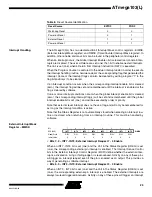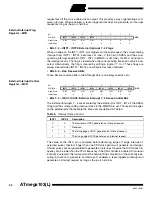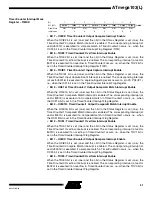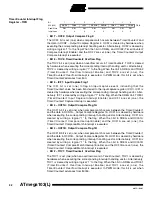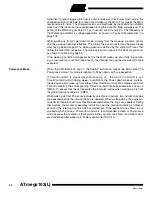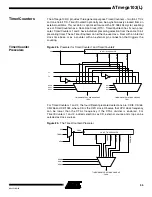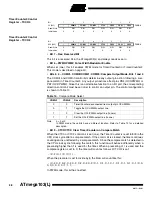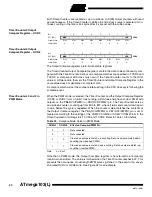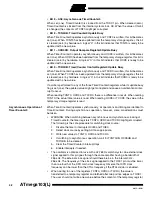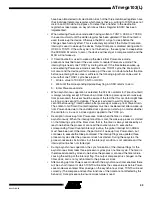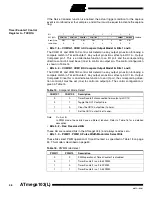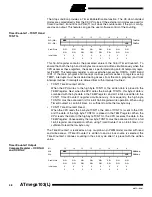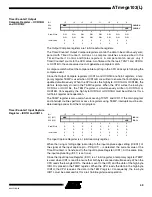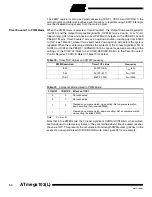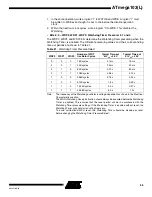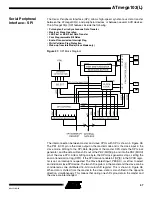
42
ATmega103(L)
0945G–09/01
• Bit 3 – AS0: Asynchronous Timer/Counter0
When set (one), Timer/Counter0 is clocked from the TOSC1 pin. When cleared (zero),
Timer/Counter0 is clocked from the internal system clock, CK. When the value of this bit
is changed, the contents of TCNT0 might get corrupted.
• Bit 2 – TCN0UB: Timer/Counter0 Update Busy
When Timer/Counter0 operates asynchronously and TCNT0 is written, this bit becomes
set (one). When TCNT0 has been updated from the temporary storage register, this bit
is cleared (zero) by hardware. A logical “0” in this bit indicates that TCNT0 is ready to be
updated with a new value.
• Bit 1 – OCR0UB: Output Compare Register0 Update Busy
When Timer/Counter0 operates asynchronously and OCR0 is written, this bit becomes
set (one). When OCR0 has been updated from the temporary storage register, this bit is
cleared (zero) by hardware. A logical “0” in this bit indicates that OCR0 is ready to be
updated with a new value.
• Bit 0 – TCR0UB: Timer/Counter Control Register0 Update Busy
When Timer/Counter0 operates asynchronously and TCCR0 is written, this bit becomes
set (one). When TCCR0 has been updated from the temporary storage register, this bit
is cleared (zero) by hardware. A logical “0” in this bit indicates that TCCR0 is ready to be
updated with a new value.
If a write is performed to any of the three Timer/Counter0 registers while its update busy
flag is set (one), the updated value might get corrupted and cause an unintentional inter-
rupt to occur.
When reading TCNT0, OCR0 and TCCR0, there is a difference in result. When reading
TCNT0, the actual timer value is read. When reading OCR0 or TCCR0, the value in the
temporary storage register is read.
Asynchronous Operation of
Timer/Counter0
When Timer/Counter0 operates synchronously, all operations and timing are identical to
Timer/Counter2. During asynchronous operation, however, some considerations must
be taken.
•
WARNING: When switching between asynchronous and synchronous clocking of
Timer/Counter0, the timer registers TCNT0, OCR0 and TCCR0 might get corrupted.
The following is the safe procedure for switching clock source:
1.
Disable the timer 0 interrupts OCIE0 and TOIE0.
2.
Select clock source by setting ASO as appropriate.
3.
Write new values to TCNT0, OCR0 and TCCR0.
4.
If switching to asynchronous operation, wait for TCNT0UB, OCR0UB and
TCR0UB to be cleared.
5.
Clear the Timer/Counter0 interrupt flags.
6.
Enable interrupts if needed.
•
The oscillator is optimized for use with a 32,768 Hz watch crystal. An external clock
signal applied to this pin goes through the same amplifier having a bandwidth of
256 kHz. The external clock signal should therefore be in the interval 0 Hz -
256 kHz. The frequency of the clock signal applied to the TOSC1 pin must be lower
than one fourth of the CPU main clock frequency. Observe that CPU clock
frequency can be lower than the XTAL frequency if the XTAL divider is enabled.
•
When writing to one of the registers TCNT0, OCR0 or TCCR0, the value is
transferred to a temporary register and latched after two positive edges on TOSC1.
The user should not write a new value before the contents of the temporary register


